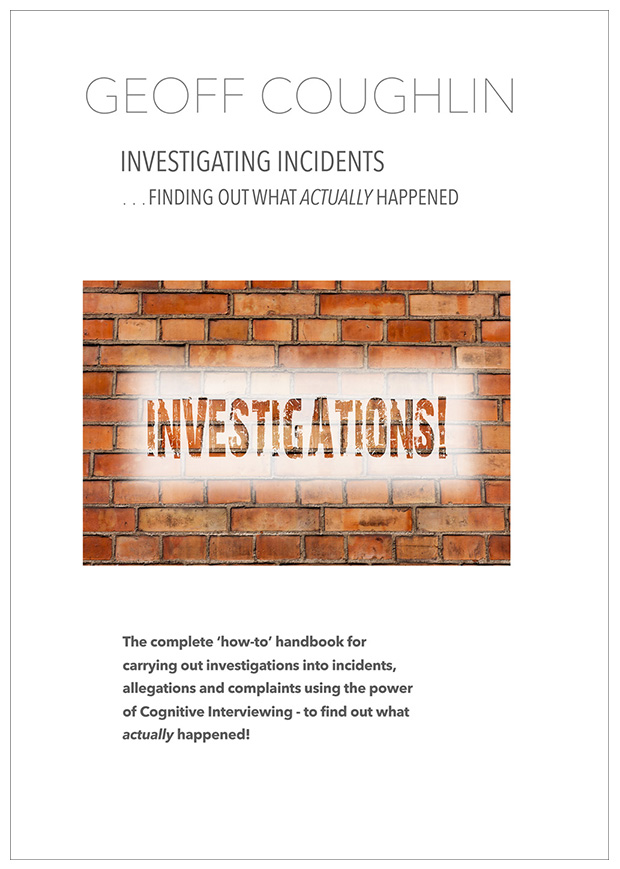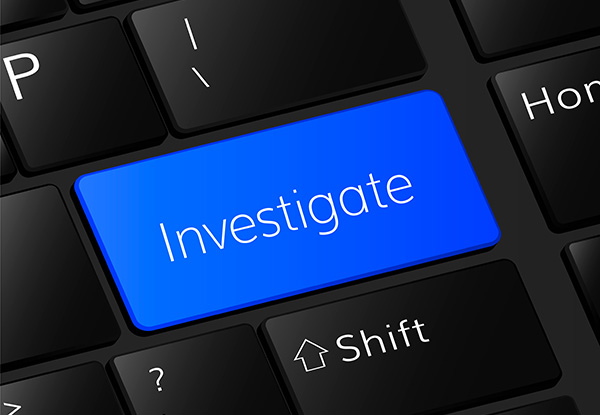Investigating Incidents - Finding Out What ACTUALLY Happened

A comprehensive ‘how-to’ handbook for anyone tasked with or involved in carrying out investigations.
200 pages
Available from Kindle Books as an e-book only so that you can access the content anywhere and whenever you need to!
Content: 3 Main Sections – at a glance content
Section One – How to structure an investigation
- how to structure an investigation – planning and implementing your investigation using the N.A.O.M.I.E systematic planning model
- how to establish 2 clear roles for any investigation:
– Level A Investigators – directors and managers tasked with responsibility for initiating an investigation and establishing clear terms of reference and objectives
– Level B Investigators – managers, staff and individuals tasked with carrying out the work of the investigation and reporting back to Level A - evidence – the different types such as physical and people and what to do with it
- gathering evidence – Level A and B responsibilities
- how to identify and apply best practice when conducting investigations.

Section Two – The skills needed to carry out any investigative interview
- identifying the skills needed to carry out investigations and how to apply them effectively
- special focus on the use of the Cognitive Interview (CI) approach when questioning all individuals during the investigation
- how to consistently use open, non-leading questions, to probe into issues and topics of interest
- how to create a clear structure and plan for any investigative interview they need to carry out
- how to get to the heart of what actually happened, elicit the facts, rather than accept any other version of events
- how to identify an interview strategy and order for interviewing all individuals who fall within the scope of the investigation
- how to deploy an approach that is sufficiently probing, robust and appropriate in different contexts
- how to handle evasive interviewees and keep them on side
- how to take accurate notes yet maintain high levels of engagement and rapport during all interviews
- how to confront inconsistencies in what you are told as an investigator and interviewer
- how to avoid many of the pitfalls of poor and ineffective investigative and interview practice.
Section Three – Writing simple witness statements, concluding and reporting back findings of any investigation
- Detecting lies and deceit
A summary of the relevant cognitive psychological theory and other useful references and links - Key reference materials
- Contact details for Geoff Coughlin
- Appendix A – CI Summary of whole CI Process
- Appendix B – Summary of Using the Recall Techniques
- Appendix C – NAOMIE, Investigations
- Appendix D – Eye Patterns diagram and explanation
Author’s Introduction
 I’ve been fortunate enough over many years to have had the opportunity to work with many organisations, from NHS Trusts to law firms, from regulators to businesses. All have had one thing in common – they needed help with the ‘how-to’ of carrying out effective investigations.
I’ve been fortunate enough over many years to have had the opportunity to work with many organisations, from NHS Trusts to law firms, from regulators to businesses. All have had one thing in common – they needed help with the ‘how-to’ of carrying out effective investigations.
It’s been a privilege to help the people at the heart of these organisations get on with the difficult and challenging tasks that make up an effective, successful investigation. Some of these organisations seem to be on the receiving end of endless pronouncements and requirements to act, to find out what happened, to get to the bottom of serious allegations and untoward incidents. For others, the need to carry out investigations is rare and they are unclear about how to proceed.
The question many struggle with though is the How! They say… “yes, we know that we have to find out what happened, yes, we know what we have to do, but how do we do it?”
I can help! That’s what this book is all about, a resource to help you with the ‘How’ of carrying out different investigations.
What I offer you here is a practical toolkit, a resource that you can dip into for any element of the process.
I am also asked on occasions to conduct real-live live investigations for some my clients and this proves invaluable in honing my own skills and approach so that I can bring real-life experiences and knowledge to others on the training courses that I run and in books such as this.
Cognitive Interviewing (CI)
This highly effective and practical interview approach comprises a number of memory retrieval techniques that are designed to enable a witness or subject to remember more fully and accurately what happened, even many months or years ago. It involves deploying a forensic approach to your interview practice that works and acts with the key principles of memory and memory recall, rather than against it.
CI therefore lies at the heart of any interview when the interviewer (investigator) seeks to elicit the facts of what actually happened. The approach has been tried and tested endlessly for the past few decades and found to generate much more accurate and comprehensive factual recall than simply asking people questions.
Learning how to use the CI approach to generate high quality facts in the most effective way possible is a core part of this book and you will find significant chapters devoted to it.
Try to be open-minded…
To try and make this book make sense to as many people as possible engaging in investigative activities means that at some point when reading what follows you may pause and question its relevance to your own work. This is perfectly normal and I hope that you will try and see the value of that stage or activity in the investigative process and then go on to think how best you can apply it in your own work.
Inevitably, all of what follows won’t always be exactly applicable to your context and situation (although much of it will be) and what I ask is that you try to remain open-minded and challenge your thinking, your practice and that of your colleagues.
These then are the Aims of this book…
To provide a practical resource and toolkit for anyone tasked with co-ordinating or carrying out investigations in a wide range of contexts – examples are:
- internal disciplinary investigations
- health and safety investigations
- health service investigations into alleged untoward incidents and complaints
- regulatory investigations into conduct of registrants and practitioners
- associations, clubs and society investigations
- many other investigations.
To provide practical ways to develop personal effectiveness and enhance the skills and professionalism of anyone tasked with responsibility for initiating an investigation or carrying out the key roles such as staff and witness interviews as well as handling key documents and exhibits
Who this book is aimed at
Primarily those individuals who conduct or are involved in investigations within a civil environment. This book is not aimed at those officers and agents working in law enforcement agencies and who are dealing with criminal work. Having said that, much of what is contained within these pages will indeed be helpful and offer practical approaches and ideas that are consistent with ‘best-practice’ to anyone conducting ‘suspect’ interviews and criminal investigations.
- any directors and managers responsible for initiating investigations
- any managers and staff members carrying out the key tasks of the investigation
- consultants and professionals external to an organisation and appointed to carry out the investigation or any part of it
- legal professionals and staff members who work in-house for regulatory bodies and councils who are tasked with initial investigations into allegations and complaints
- health and safety professionals and managers.
